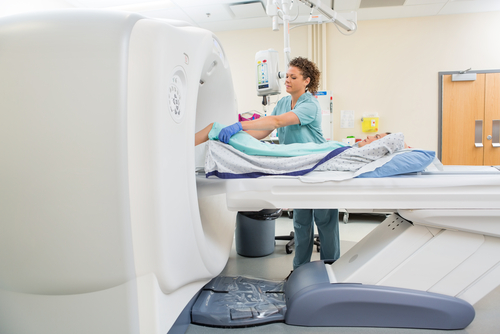Researchers at Princess Margaret Cancer Centre in Toronto, Canada, found that early MRI-based screening reduces breast cancer mortality among women survivors of childhood Hodgkin’s lymphoma (HL) who were treated with thoracic radiation therapy.
The study, titled “Impact of Early Breast Cancer Screening on Mortality Among Young Survivors of Childhood Hodgkin’s Lymphoma,” was published in the Journal of the National Cancer Institute.
Survivors of childhood cancers are at increased risk for delayed morbidity related to their treatment, and more effort is being directed at preventing or ameliorating late-treatment toxicity. One potentially modifiable late effect is mortality as a consequence of breast cancer among women treated with thoracic radiation therapy. Particularly, adolescent females treated with thoracic radiation therapy for HL have been shown to have a statistically significantly elevated risk of developing breast cancer, and consensus guidelines recommend the early initiation of breast cancer screening among these survivors.
Earlier work among researchers at the Princess Margaret Cancer Centre had shown that MRI detects breast cancer at early stages in young survivors who are not old enough to start standard breast cancer screening.
“If you are a young woman who was treated with radiation therapy to your chest as a teenager or child for HL, or for that matter chest radiation therapy for any reason, you should be having a conversation with your family doctor or your oncologist about whether to start breast cancer screening earlier than most women would,” Dr. David Hodgson, a radiation oncologist at the Princess Margaret Cancer Centre, said in a news release.
“Many of these are women who received radiotherapy to more normal tissue or at higher doses than are used currently, but even for more recently treated patients, screening should reduce the risk of breast cancer death,” Hodgson said.
The team gathered information from published studies on the risk for breast cancer in childhood lymphoma survivors. They also looked for studies assessing the precision of different forms of breast cancer screening and the rates at which women agree to be screened. Using a mathematical model of breast cancer, researchers evaluated the marginal benefit of early screening of female survivors of adolescent HL on breast cancer mortality — screening at age 25 compared to age 40.
Using mammography, about 260 survivors of childhood lymphoma would need to have early breast cancer screening to prevent one breast cancer death, a result that is comparable to the screening programs for average-risk women age 50 or older, which usually requires 300-1,300 women to prevent one breast cancer death. The use of MRI for screening also significantly improved the effectiveness when compared to mammography, reducing the number of women who needing screening to prevent one breast cancer death to fewer than 80.
However, Hodgson cautioned that false positive MRI results are common, as MRI is so sensitive that it detects many alterations in the breast tissue, most of which are not cancer. The study findings show that between the ages of 25 to 39, about a third of patients will have a false positive result, and as screening extends to the age of 75 years, about 80 percent of women screened with MRI will have at least one false positive.
“So this is important for patients to know and for physicians to counsel patients about because it’s stressful for a patient to be called back about suspicious findings,” Hodgson said.

